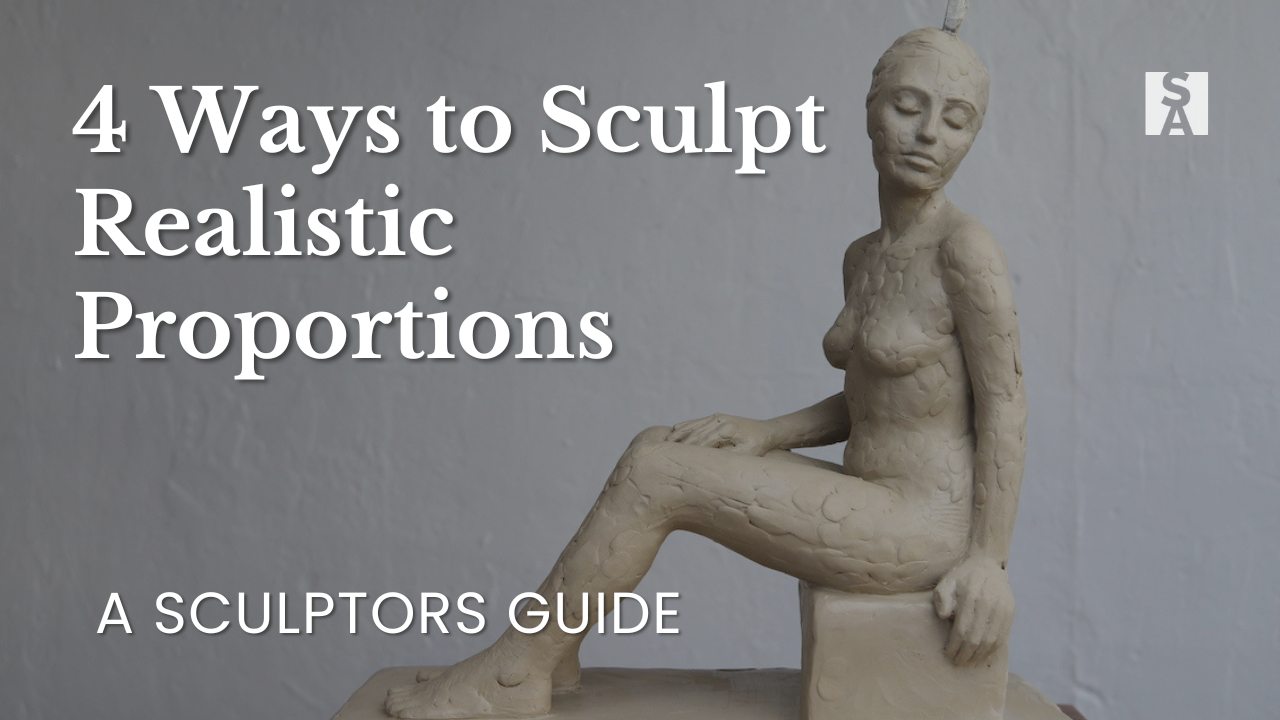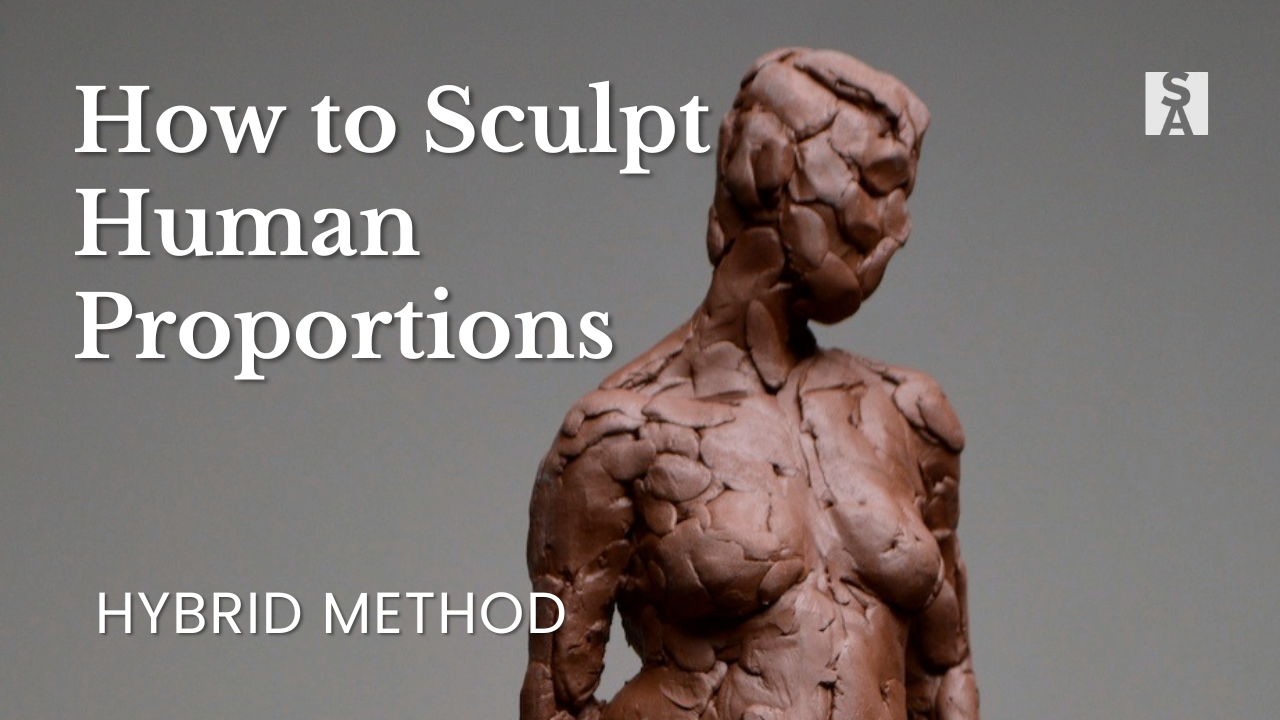Best Clay for Sculpting Beginners: What to Use (and What to Avoid)

If you're a beginner just starting out with sculpture, the first question is usually:
"What clay should I use?"
Search online and you’ll be hit with a flood of opinions: air-dry, polymer, pottery, oil-based… and a whole lot of confusion. Most guides list too many options, and very few explain the best clay for sculpting beginners who want to learn traditional sculpting for portraits, figures, and fine art (not dolls or craft projects).
The truth? A lot of beginners get stuck before they even begin because they are afraid of choosing the wrong material.
Let’s simplify it.
Table of Contents
- The Problem with Most Clay Advice
- Why Water-Based Clay Is the Best Choice
- Where to Find It (Even If You're Just Starting)
- What Clay Types to Avoid
- Get Set Up: Free Beginner Workshop
After teaching hundreds of beginners, I recommend one clay almost every time:
Water-based sculpting clay.
You can get it at almost any art store. It’s affordable, responsive, and lets you actually learn how to sculpt without worrying about expensive materials or complicated casting processes.
In this post, I’ll explain:
- Why water-based clay is the best choice for beginners
- Where to find a good sculpting clay near you
- What types of clay to avoid (and why)
- Free resources to help you get set up to sculpt from home
Want to see how it works? Join the free online Beginner Sculpting Workshop to learn setup, tools, and how to create your first project in clay.
The Problem with Most Clay Advice
If you search “best clay for beginners,” you’ll find hundreds of opinions, and most of them conflict. That’s because the right clay depends entirely on what kind of sculpture you want to make.
Some clays are better for dollmaking. Others are used for special effects, miniatures, or decorative crafts. But if you want to learn traditional sculpture techniques - the kind taught in classical ateliers and fine art studios - most of that advice will just confuse you or lead you in the wrong direction.
Best clay for beginners who want to learn traditional sculpture

If you’re making dolls, miniatures, or fantasy figures, this probably isn’t the right guide for you.
This guide is for beginners who want to:
- Sculpt realistic portraits, animals, or figures
- Build foundational skills in observation, proportion, and structure
- Use a material that’s malleable, forgiving, and ideal for learning
Why Water-Based Clay Is the Best Choice
If you're serious about learning how to sculpt, water-based clay is the most beginner-friendly material for building real skill. If you’re searching for the best clay for sculpting beginners, this is it.
It’s hands-down the most accessible, versatile material for learning how to shape form, develop your eye, and build foundational technique. That’s why it’s used in nearly all classical studios - it teaches you how to see, shape, and refine form without overcomplicating your setup.

5 Reasons I recommend Water-based Clay for Beginners:
- Soft and responsive when fresh – This makes it easy to shape large forms quickly and explore gesture, proportion, and overall structure without resistance.
- Firms up gradually – As it begins to dry, it naturally supports more refined detail. This allows you to build your sculpture in layers—starting loose, then moving toward precision.
- Can be fired (or not) – You don’t need to commit to a finished piece right away. But if you do create something you’re proud of, it’s easy to fire and preserve it permanently once you learn how to hollow the form.
- Trains your eye and hand – Because water-based clay reacts to pressure, tool marks, and subtle changes, it helps you develop the tactile sensitivity and visual awareness every sculptor needs.
- Versatile for faces, figures, or animals – No matter where you want to go with your sculpting later, this clay supports it. It’s the material I recommend to all my beginner students.
No matter what direction you want to go with your sculpting later, this clay supports it. It’s the material I recommend to all my beginner students.
You don’t need anything fancy to get started.
Now that you know the benefits, here’s how to find the right clay locally.
Where to Find Sculpting Clay

Finding water-based sculpting clay is usually pretty simple, and you don’t need to special-order anything to get started. Most local art stores carry exactly what you need, you just have to know what to ask for.
What Clay to Ask for at the Art Store
- Water-based modeling clay – This is often labeled as “pottery clay” ,“ceramic clay” or “modelling clay.”
- Ask for a clay that’s suitable for hand-building or figure sculpting – not wheel throwing.
- Look for a clay with fine grog (optional) – Grog is small pieces of fired clay added into the clay body to help it be more resistant. A fine grog means the clay will be smoother and easier to shape, especially for portraits or small details. Avoid coarse grog as it is gritty and makes it harder to refine the surface texture.
- Yes, this is the kind of clay you fire in a kiln – But you don’t need to fire it right away. You can explore, learn, and even reuse clay during your early projects.
TIP: Check pottery or sculpture suppliers – They offer more variety, especially if you want to try different clays later. If you're brand new, just head to your nearest art store and ask for water-based clay suitable for sculpting. You’ll be off to a strong start.
As far as color, you can choose whatever you like: a red terracotta, a smooth grey or an off-white color. My personal preference is an off-white or light grey clay because it makes it easier to see the shadows as you sculpt.
What Sculpting Clays to Avoid (for Now)
Not all clay is beginner-friendly, even if it’s marketed that way. Using the wrong material can make sculpting feel frustrating instead of exciting.
Here’s what I recommend avoiding when you're just starting out:
Clays That Might Sound Easy - But Can Make Sculpting Harder
- Air-Dry Clay – Often lacks plasticity which makes it hard to model sculptural forms quickly or easily. It doesn’t give beginners the same tactile feedback or shaping control as water-based clay. Plus, it can crack or warp as it dries, especially if the sculpture is too large or uneven in thickness.
- Polymer Clay (e.g. Sculpey) – Best suited for miniatures or small oven-baked figurines. It’s expensive, lacks the structure and responsiveness of traditional clay, and the particular working methods make it harder to learn the principles of mass and form.
- Porcelain or Coarse Grog Clay – Porcelain is fickle and prone to cracking unless you're already experienced. Clays with heavy grog feel sandy, are difficult to smooth, and don’t hold subtle forms well.
- Oil-Based Clay (Plastilina) – It doesn’t dry, which makes it ideal for moldmaking and studio studies - but it’s not ideal for beginners who want to make finished sculptures. Moldmaking requires extensive setup, knowledge and materials to create a permanent piece.
Want a full comparison of the most common clay types? Read: Best Clay for Figure Sculpting – A Beginner’s Guide
Frequently Asked Questions
Q: What is the best clay for sculpting beginners?
A: Water-based sculpting clay is the best choice. It’s affordable, responsive, easy to find, and perfect for learning foundational sculpting skills, especially for portraits and figures.
Q: Can beginners use air-dry clay for sculpting?
A: Air-dry clay is not ideal. It lacks the plasticity and feedback needed to learn proper form, and it often cracks, especially in larger or thicker pieces.
Q: Do I need a kiln to start sculpting?
A: No. You can sculpt, learn, and even reuse water-based clay without firing it. Firing is optional and only necessary when you want to preserve a finished piece permanently.
Q: Where can I buy sculpting clay as a beginner?
A: Most local art stores carry it. Ask for “water-based clay for hand-building or figure modeling.” Look for a fine grog clay for added strength.
Ready to Sculpt with Confidence? Join the Free Beginner Workshop
Even with the right clay, most beginners hit the same roadblock:
"Now what?"
You don’t need a big studio to begin sculpting. This free intro workshop walks you through tools, setup, and your first project - step by step - so you can stop overthinking and start sculpting with confidence.
Free Beginner Sculpting Workshop: Learn the Right Way to Start

In just 3 short video lessons, you'll learn:
- Essential principles that will train your eye to start seeing form like a sculptor
- How to set up your workspace with confidence (even in a small space)
- The exact sculpting tools I recommend for beginners
- How to work with water-based clay effectively
- A complete tutorial to sculpt your first simple project
Whether you want to sculpt portraits, animals, or figures, this is where it all starts.
→ Get Instant Access to the Beginner Workshop Here
It’s free and designed to get you sculpting the right way from day one.
ARE YOU ON THE LIST?
Online Atelier Program for Sculpture:
Master the foundations of traditional clay figure sculpting.
Next Enrolment January 2026.
Enter Your Details Below to Get Notified:
You can unsubscribe at any time.




